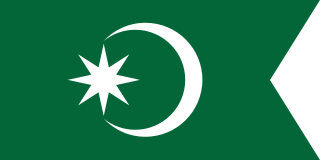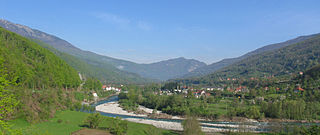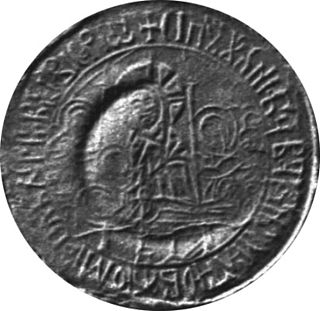 W
WThe campaign to establish Austro-Hungarian rule in Bosnia and Herzegovina lasted from 29 July to 20 October 1878 against the local resistance fighters supported by the Ottoman Empire. The Austro-Hungarian Army entered the country in two large movements: one from the north into Bosnia, and another from the south into Herzegovina. A series of battles in August culminated in the fall of Sarajevo on the 19th after a day of street-to-street fighting. In the hilly countryside a guerrilla campaign continued until the last rebel stronghold fell after their leader was captured.
 W
WThe Battle of Grahovac took place in the eponymous village of Grahovac from 29 April to 1 May 1858, when Montenegrin Grand Duke Mirko Petrović-Njegoš led the army of Principality of Montenegro against the Ottomans, ending in a decisive Montenegrin victory. After the victory, the demarcation of the border between Montenegro and the Ottoman Bosnia Eyalet was finalised. A considerable arsenal of war trophies was captured following the retreat of the Ottoman army.
 W
WThe Battle of Vučji Do was a major battle that took place on 18 July 1876 in Vučji Do, Sanjak of Herzegovina, fought between the combined forces of Montenegrin and Eastern Herzegovinian tribes (battalions) against the Ottoman Army under Grand Vizier Ahmed Muhtar Pasha. The Montenegrin-Herzegovinian forces heavily defeated the Ottomans, and managed to capture two of their commanders. In addition, they captured a large consignment of armament.
 W
WThe Battles for Plav and Gusinje were armed conflicts between the Principality of Montenegro and Ottoman irregular armies that broke out following the decision of the Congress of Berlin (1878) that the territories of Plav and Gusinje be ceded to Montenegro. The conflicts took place in this territory between 9 October 1879 and 8 January 1880. The following battles were fought:Velika attacks, Montenegrin victory Battle of Novšiće, Ottoman irregular victory Battle of Murino, Montenegrin victory
 W
WThe Eyalet of Bosnia, was an eyalet of the Ottoman Empire, mostly based on the territory of the present-day state of Bosnia and Herzegovina. Prior to the Great Turkish War, it had also included most of Slavonia, Lika, and Dalmatia in present-day Croatia. Its reported area in 1853 was 52,530 square kilometres (20,281 sq mi).
 W
WThe Bosnia Vilayet was a first-level administrative division (vilayet) of the Ottoman Empire, mostly comprising the territory of the present-day state of Bosnia and Herzegovina, with minor parts of modern Montenegro. It bordered Kosovo Vilayet to the south. Before the administrative reform in 1867, it was called the Bosnia Eyalet. In the late 19th century it reportedly had an area of 46,000 square kilometres (17,900 sq mi).
 W
WThe Eyalet of Herzegovina was an Ottoman eyalet from 1833 to 1851. Its last capital was Mostar.
 W
WJovan Kantul, sometimes numbered Jovan II was the Archbishop of Peć and Serbian Patriarch, the spiritual leader of the Serbian Orthodox Church, from 1592 until his death in 1614. He planned a major revolt in the Ottoman Balkans, with Grdan, the vojvoda of Nikšić, asking the pope for aid. Owing to his activities for planning a Serbian revolt, he was arrested and put on trial in Istanbul in 1612. He was found guilty of treason and was executed two years later (1614).
 W
WThe Vilayet of Kosovo was a first-level administrative division (vilayet) of the Ottoman Empire in the Balkan Peninsula which included the current territory of Kosovo and the north-western part of the Republic of North Macedonia. The areas today comprising Sandžak (Raška) region of Serbia and Montenegro, although de jure under Ottoman control, were in fact under Austro- Hungarian occupation from 1878 until 1909, as provided under Article 25 of the Treaty of Berlin. Uskub (Skopje) functioned as the capital of the province and the mid way point between Istanbul and its European provinces. Uskub's population of 32,000 made it the largest city in the province, followed by Prizren, also numbering at 30,000.
 W
WOn the third day of Serbian Christmas, January 8, 1880, about a month after the battle of Novšiće, around 10,000 pro-Ottoman Albanians attacked the Montenegrin forces numbering 3,000, led by commanders Marko Miljanov and Todor Miljanov and priest Đoko, in Murino. At this battle, the Montenegrin forces were made up of the Bratonožići, Vasojevići and Moračani. The Albanians, among whom were Ottoman regulars, had 1,400 casualties, the Montenegrins 36 dead and 70 wounded.
 W
WThe Battle of Novšiće ) was a battle for control over Plav and Gusinje fought on 4 December 1879 between the forces of Principality of Montenegro led by Marko Miljanov and local pro-Ottoman forces which included irregulars of the League of Prizren, both commanded by Ali Pasha, the Kaymekam of Gusinje. The League of Prizren consisted of the local Albanians and Bosniaks from Plav and Gusinje in Scutari Vilayet and irregulars from Kosovo Vilayet. Some of them where Muslims of Montenegrin origin like Husein Bektešević.
 W
WThe Sanjak of Novi Pazar was an Ottoman sanjak that was created in 1865. It was reorganized in 1880 and 1902. The Ottoman rule in the region lasted until the First Balkan War (1912). The Sanjak of Novi Pazar included territories of present-day northeastern Montenegro and southwestern Serbia, also including some northern parts of Kosovo. The region is known as Raška, and also called Sandžak.
 W
WThe Sanjak of Novi Pazar was an Ottoman sanjak that was created in 1865. It was reorganized in 1880 and 1902. The Ottoman rule in the region lasted until the First Balkan War (1912). The Sanjak of Novi Pazar included territories of present-day northeastern Montenegro and southwestern Serbia, also including some northern parts of Kosovo. The region is known as Raška, and also called Sandžak.
 W
WThe Sanjak of Scutari or Sanjak of Shkodra was one of the sanjaks of the Ottoman Empire. It was established after Ottoman Empire acquired Shkodra after the siege of Shkodra in 1478-9. It was part of Rumelia Eyalet until 1867, when it became a part, together with Sanjak of Skopje, of newly established Scutari Vilayet. In 1912 and beginning of 1913 it was occupied by members of Balkan League during the First Balkan War. In 1914 the territory of Sanjak of Scutari became a part of Principality of Albania, established on the basis of peace contract signed during London Conference in 1913.
 W
WThe Serb uprising of 1596–1597, also known as the Herzegovina uprising of 1596–1597, was a rebellion organized by Serbian Patriarch Jovan Kantul and led by Grdan, the vojvoda ("duke") of Nikšić against the Ottomans in the Sanjak of Herzegovina and Montenegro Vilayet, during the Long Turkish War (1593–1606). The uprising broke out in the aftermath of the failed Banat Uprising in 1594 and the burning of Saint Sava's relics on April 27, 1595; it included the tribes of Bjelopavlići, Drobnjaci, Nikšić, and Piva. The rebels, defeated at the field of Gacko in 1597, were forced to capitulate due to a lack of foreign support.
 W
WThe Siege of Castelnuovo was an engagement during the Ottoman-Habsburg struggle for control of the Mediterranean, which took place in July 1539 at the walled town of Castelnuovo, present-day Herceg Novi, Montenegro. Castelnuovo had been conquered by elements of various Spanish tercios the year before during the failed campaign of the Holy League against the Ottoman Empire in Eastern Mediterranean waters. The walled town was besieged by land and sea by a powerful Ottoman army under Hayreddin Barbarossa, who offered an honourable surrender to the defenders. These terms were rejected by the Spanish commanding officer Francisco de Sarmiento and his captains even though they knew that the Holy League's fleet, defeated at the Battle of Preveza, could not relieve them. During the siege, Barbarossa's army suffered heavy losses due to the stubborn resistance of Sarmiento's men. However, Castelnuovo eventually fell into Ottoman hands and almost all the Spanish defenders, including Sarmiento, were killed. The loss of the town ended the Christian attempt to regain control of the Eastern Mediterranean. The courage displayed by the Old Tercio of Naples during this last stand, however, was praised and admired throughout Europe and was the subject of numerous poems and songs. Even the Venetian refused the promised naval link to Castelnuovo with the supplies and reinforcements; after a general troop parliament, the Capitan Francisco de Sarmiento answer to the Barbarossa surrender question was: "Que vengan cuando quieran".
 W
WDuring the implementation of the Congress of Berlin, when the Principality of Montenegro had received Plav and Gusinje, the surrounding Albanian populace under the guise of the Ottomans attacked the Montenegrin forces in Velika at two occasions, on October 9 and November 22, 1879. The Ottomans were defeated.
 W
WVisarion was the Metropolitan of Herzegovina between 1590 and 1602.